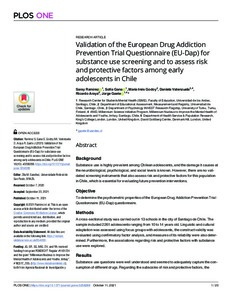Validation of the European Drug Addiction Prevention Trial Questionnaire (EU-Dap) for substance use screening and to assess risk and protective factors among early adolescents in Chile
Godoy María Inés; Gaete Jorge; Araya Ricardo; Ramirez Sarray; Gana Sofia; Valenzuela Daniela
https://urn.fi/URN:NBN:fi-fe2021120158348
Tiivistelmä
Background
Substance use is highly prevalent among Chilean adolescents, and the damage it causes at the neurobiological, psychological, and social levels is known. However, there are no validated screening instruments that also assess risk and protective factors for this population in Chile, which is essential for evaluating future prevention interventions.
Objective
To determine the psychometric properties of the European Drug Addiction Prevention Trial Questionnaire (EU-Dap) questionnaire.
Methods
A cross-sectional study was carried out in 13 schools in the city of Santiago de Chile. The sample included 2261 adolescents ranging from 10 to 14 years old. Linguistic and cultural adaptation was assessed using focus groups with adolescents, the construct validity was evaluated using confirmatory factor analysis, and measures of its reliability were also determined. Furthermore, the associations regarding risk and protective factors with substance use were explored.
Results
Substance use questions were well understood and seemed to adequately capture the consumption of different drugs. Regarding the subscales of risk and protective factors, the analyses showed that most subscales had good psychometric properties, and few needed some degree of improvement (e.g., some items were removed). After the changes, most final subscales had good or adequate goodness of fit adjustments and good or acceptable internal consistency. Finally, the main associated factors with the substance use outcomes were: future substance use and school bonding for tobacco use; negative beliefs about alcohol, future substance use, school bonding and refusal skills for alcohol use; and negative beliefs about marihuana, positive attitudes towards drugs, risk perception, and substance abuse index for marihuana use. Normative beliefs increased the risk for all substances use.
Conclusions
The current findings suggest that the EU-Dap is a valid and reliable instrument, and it may help to evaluate the effectiveness of drug use prevention interventions.
Kokoelmat
- Rinnakkaistallenteet [19218]
